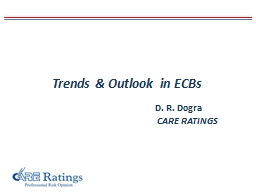

D R Dogra CARE RATINGS Contents External Commercial Borrowings over the years Outstanding ECBs Purpose wise Breakup of ECB for 9MFY16 Purpose Share in total Refinancing ID: 1029532
Download Presentation The PPT/PDF document "Trends & Outlook in ECBs" is the property of its rightful owner. Permission is granted to download and print the materials on this web site for personal, non-commercial use only, and to display it on your personal computer provided you do not modify the materials and that you retain all copyright notices contained in the materials. By downloading content from our website, you accept the terms of this agreement.
1. Trends & Outlook in ECBs D. R. Dogra CARE RATINGS
2. Contents
3. External Commercial Borrowings over the years
4. Outstanding ECBs
5. Purpose wise Breakup of ECB for 9MFY16PurposeShare in total (%)Refinancing 38.5On Lending/Sub Lending12.9Rupee Expenditure11.8Import of Capital Goods10.7Telecommunication5.0New Projects4.7General Corporate Purpose4.6Modernization3.5Miscellaneous2.8Working Capital 1.9Power1.2Ports1.0Overseas Acquisition1.0Urban Infrastructure0.1Micro Finance0.1
6. ECB and Interest Rate
7. ECB and other Finance Avenues
8. Regulatory Framework The lenders and investors are divided into three tracks Minimum Average Maturity (MAM) PeriodTrack I (Eg: Companies in manufacturing, shipping, software, airlines etc)3 years for ECB upto USD 50 million or its equivalent 5 years for ECB beyond USD 50 million or its equivalentTrack II ( Eg: Infrastructure companies, holding companies etc)10 years irrespective of the amountTrack III ( Eg: NBFCs, MFIs, companies involved in R&D)Same as under Track I
9. Regulatory Framework All-in-Cost (AIC)Track IFor ECB with min average maturity period of 3 to 5 years - 300 basis points per annum over 6 month LIBOR or applicable bench mark for the respective currency.For ECB with average maturity period of more than 5 years – 450 basis points per annum over 6 month LIBOR or applicable bench mark for the respective currencyTrack IIThe maximum spread over the bench mark will be 500 basis points per annum. Remaining conditions will be as given under Track ITrack IIICost linked with market conditions
10. Regulatory FrameworkIndividual Limits The individual limits of ECB that can be raised by eligible entities under the automatic route per financial year for all the three tracks are set out as under:Upto USD 750 million or equivalent for the companies in infrastructure and manufacturing sectors;Upto USD 200 million or equivalent for companies in software development sector;Upto USD 100 million or equivalent for entities engaged in micro finance activities; andUpto 50 million or equivalent for remaining entities.
11. Contents
12. Differential Interest Rates
13. Perception on Exchange rate
14. Derivatives Market MonthsNo of Contracts for the month of Jan’16February52,92,090March4,82,166April1,92,469May80,933June34,355July26,176August2,400September2,338October1,330
15. Company Specific IssuesSmall companies preference for banksGiven the state of their balance sheets and governance levels, may not be able to access the marketThe country rating becomes important as it acts as one of the benchmarks for pricing in the marketCompany rating becomes important Lower rated companies find it difficult to use this avenueOften a CDS written by a bank on such loans taken where the swap cost could be a deterrent
16. Contents
17. Pressure on External Debt Increasing share of ECBs in the external debt
18. Corporate ConcernsAccess to the marketLimits placed by the RBI Ceiling on ratesUn-hedged positionStress on balance sheetRepayment concerns
19. Contents
20. Way Forward ECB important avenue for resourcesMismatch between demand and supply in the India1 trillion dollar investment needed in infrastructure and manufacturing Banks have limitations in the form of NPAsLimited institutions to look at other form of borrowingFDI more sector specificAssuming a 1:1 ratio, borrowing through ECB can be up to $ 30 billion
21. Way Forward Need to build a buoyant derivatives marketNecessary to hedge in derivativesLong term contracts ECB limits to be liberalized further in a graded manner with ceiling to be increased based on market conditions
22. Thank You